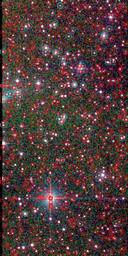 |
| Figure 1 - Click this image to view an illustration of 6x catalog generation results on an image in the Abell 553 6x field. |
The 2MASS 6x Point and Extended Source Catalogs (6x-PSC and 6x-XSC) are the reliable and uniform subsets of source detections drawn from the 6x Working Databases (WDBs), just as the All-Sky Release PSC and XSC were drawn from the main survey WDBs. The objectives and process of generating the 6x Catalogs are analogous to those used to produce the 2MASS All-Sky Release PSC and XSC, as described in Section V. While there was not an equivalent set of Level 1 Science Requirements for the 6x observations and data products, the goal is to achieve the same standards of reliability, completeness, sensitivity and uniformity at approximately one magnitude fainter flux levels than the main survey, within the limitations of source confusion.
Pipeline processing of the raw 6x imaging data (A3.5) produced an Image Atlas and extracted source WDBs containing 24,023,702 and 247,091 "detections" of point and extended sources, respectively, from 1328 scans of 6x tiles (including the LMC/SMC scans). As with the main survey WDBs, the 6x WDBs are highly complete, containing extractions of all "sources" down to SNR~3.5. In addition to the reliable source detections that eventually comprise the 6x-PSC and 6x-XSC, the 6x WDBs contain:
Catalog Generation selects a subset of extractions from the highly complete 6x WDBs to form the highly reliable and uniform 6x Catalogs. The process starts by first identifying one scan of each 6x tile from which to select sources. For tiles that were observed more than once, the scan that was taken under the best conditions of atmospheric transparency, seeing and background (A3.6.b) is identified. Extractions are then selected from the identified scans using SNR and other quality filters that guarantee the reliability of the Catalogs without compromising the completeness levels (A3.6.c). For sources in the overlap region between tiles that have more than once apparition in the WDBs, only one detection is selected for the Catalog to provide more uniform effective sensitivity (A3.6.d).
The results of catalog generation are illustrated graphically in Figure 1. The background image shows a 3-color composite 6x Atlas Image from once scan of the Abell 553, centered at approximately ra,dec=93.07°,+48.56°. Rolling the cursor over the image switches between overlays showing the 6x point and extended source WDB extractions and the 6x-PSC and 6x-XSC extractions. Point and extended source extractions are denoted by the red squares and cyan circles, respectively, in the first panel. In the second panel, sources selected for the 6x-PSC and 6x-XSC are denoted with green or white boxes and yellow or white circles, respectively.
There are several differences between the production of the 6x and All-Sky Release (main survey) Catalogs that are important to note. The most fundamental is that unlike the main survey Catalogs, the 6x Catalogs are not released as separate tables. Instead, the 6x-PSC and 6x-XSC are released as part of the 6x WDBs. The subset of extractions in the 6x WDBs that constitute the Catalogs are identified in the point and extended source tables using the cat column, and have cat=1. WDB extractions that do not satisfy the Catalog selection criteria have cat=0.
Other differences between 6x and main Survey Catalog Generation are discussed in the A3.6b-d and include:
 |
| Figure 1 - Click this image to view an illustration of 6x catalog generation results on an image in the Abell 553 6x field. |
[Last Updated: 2007 January 8; by R. Cutri]